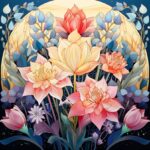Flowers are more than just a visual delight; they play a pivotal role in the reproductive process of plants through pollination. This vital biological process not only ensures the survival of plant species but also sustains entire ecosystems and supports human agriculture.
At the heart of pollination lies the transfer of pollen from the male part of the flower, the stamen, to the female part, the pistil. This can occur within the same flower, between flowers of the same plant, or between flowers of different plants. The success of this transfer is largely dependent on various pollinators, including bees, butterflies, birds, and even the wind. Each of these pollinators has a unique relationship with flowers, often attracted by their vibrant colors, enticing fragrances, and nectar rewards.
Bees, perhaps the most well-known pollinators, have evolved alongside flowers. They collect nectar for food and, in the process, inadvertently transfer pollen. Flowers have adapted to this relationship by developing specific colors and patterns that attract bees. For example, many flowers visible to bees have ultraviolet patterns guiding them to the nectar, ensuring that the bee brushes against the pollen-laden stamens.
However, the relationship between flowers and their pollinators is not solely utilitarian. It is also a delicate balance threatened by environmental changes. Habitat destruction, pesticide use, and climate change have all contributed to the decline in pollinator populations. This decline not only jeopardizes the plants that rely on these pollinators but also the broader ecosystems and human food supplies that depend on them.
In conclusion, flowers are indispensable in the process of pollination, acting as both lures and landing pads for various pollinators. This intricate dance of nature underscores the importance of protecting and preserving our natural habitats. By understanding and valuing the role of flowers in pollination, we can take steps towards ensuring a sustainable and biodiverse future.


